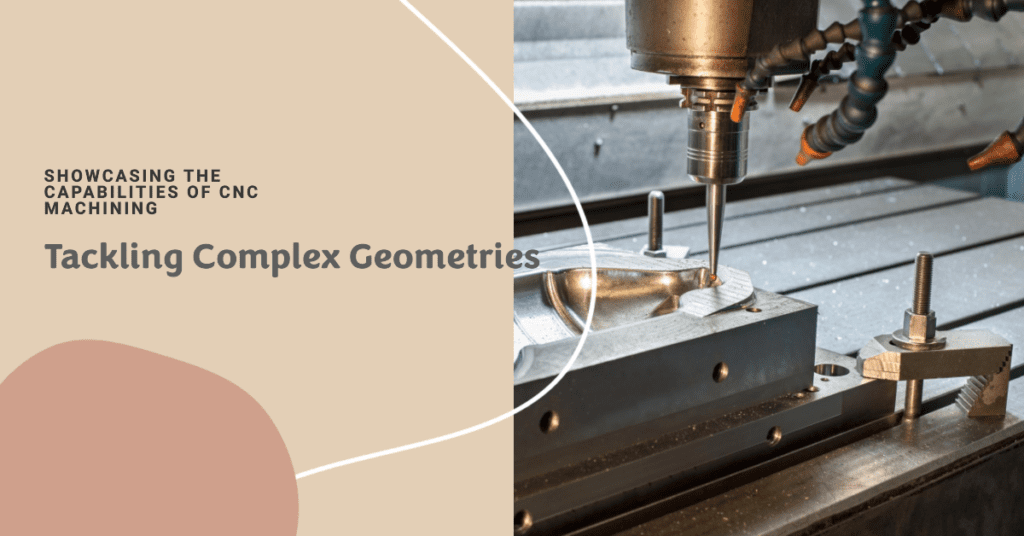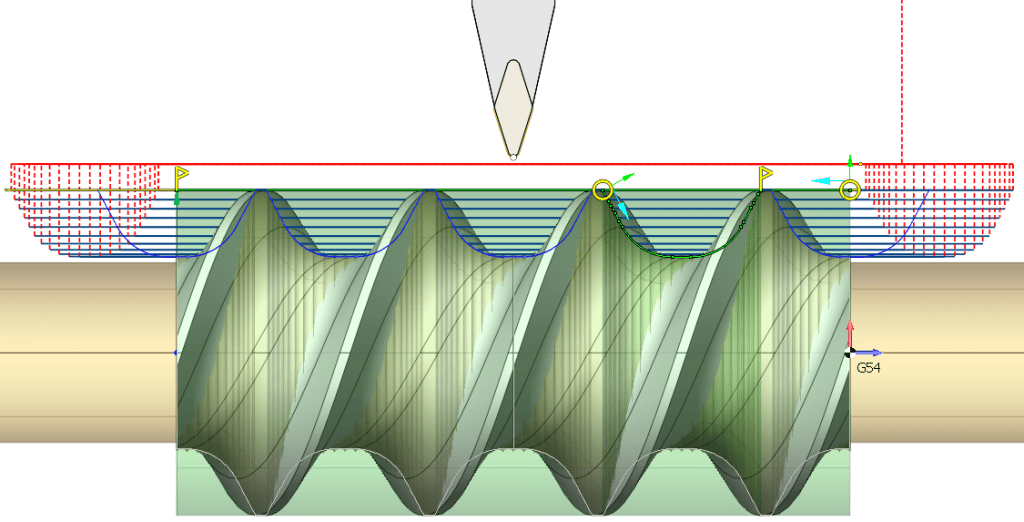
As we delve deeper into the realms of advanced manufacturing, the intricacy and complexity of part designs continue to grow. Often, these complex geometries present a considerable challenge for traditional manufacturing methods. This is where Computer Numerical Control machining steps in, demonstrating its ability to manufacture parts with precise and intricate designs.
This article illuminates some of the complex geometries that CNC machining can adeptly handle, underlining its integral role in modern manufacturing.
Understanding Geometrical Complexity in CNC Machining
CNC machining’s strength lies in its ability to navigate geometrical complexities with ease and precision, making it an ideal choice for parts demanding intricate designs. Geometrical complexity in CNC machining refers to any part or feature that goes beyond basic shapes or requires exceptional precision.
When we talk about geometrically complex parts, it doesn’t merely mean a part with an irregular or intricate shape. It can also refer to parts that have:
- High dimensional accuracy needs, which demand tight tolerances.
- Complex surface geometries, including freeform shapes or those defined by mathematical functions.
- Complicated features, like undercuts or deep narrow pockets, that are challenging to machine using conventional methods.
- High aspect ratios, which involve features significantly longer than they are wide.
To illustrate the nature of geometrical complexity in CNC machining, here’s a table that breaks down some typical features:
Table 1: Common types of geometrical complexities
| Feature | Description |
|---|---|
| Undercuts | These are recessed or hidden areas of a part, not visible from the top. |
| Deep Narrow Pockets | These are deep indentations or openings in a part, often requiring long and slender cutting tools. |
| Threads and Taps | These are helical structures used in fasteners and connectors, demanding high precision. |
| 3D Surfaces | These involve non-linear or complex geometrical shapes and patterns. |
| Tight Tolerances | This refers to the permissible limit or range in the variation of a physical dimension. |
| Multi-Axis Complexities | These are intricate geometries that require the use of multi-axis CNC machines for their creation. |
#1. Undercuts
Undercuts are challenging features for machines but are often essential in the design of specific parts. They are characterized as any indented or recessed surface that is inaccessible or hidden when viewed from a standard orthogonal view, i.e., from the top, front, or side. Undercuts can be of various types, such as T-slots, dovetails, or snap-fits, among others, and can be found in many components, from molds and dies to mechanical parts.
The manufacturing of undercuts can be complex because of their difficult-to-reach nature. Traditional machining methods can struggle with these features due to tool accessibility issues. However, CNC machining, especially 5-axis machining, is capable of handling undercuts efficiently. 5-axis machines have the capability to move tools or parts in five different axes simultaneously, allowing the tool to access hard-to-reach areas and perform complex maneuvers.
Table 2: common types of undercuts
| Type of Undercut | Description |
|---|---|
| T-slot | Named for its shape, a T-slot undercut has a narrow entrance leading to a larger cavity. |
| Dovetail | This type of undercut is wider at its base, similar to a dove’s tail. |
| Snap-Fits | These are specially designed undercuts that allow components to snap together without the need for additional fasteners. |
The ability to perform these undercuts is a testament to the versatility and capability of CNC machining. It demonstrates why, when it comes to complex geometries, CNC machining is often the preferred method.
#2. Threads

Threaded features are common in many machined parts, especially in connectors, fasteners, and valves. In essence, threads are helical structures carved into the surface of an object that enable it to screw into another object with a complementary thread.
CNC machining can handle different types of threads, including external (for bolts) and internal (for nuts). Moreover, the process can manage a variety of thread forms, from common ones like metric and Unified National Coarse (UNC) to more specialized forms like British Standard Whitworth (BSW).
Table 3: Types of Threads Common in CNC Machining
| Thread Type | Description |
|---|---|
| Metric | Widely used worldwide, identified by diameter and pitch |
| UNC (Unified National Coarse) | Common in the United States, larger thread size for a given diameter |
| UNF (Unified National Fine) | Common in the United States, smaller thread sizes for given diameter |
| BSW (British Standard Whitworth) | British standard, with a unique thread angle of 55 degrees |
#3. 3D Surfaces
3D surfaces represent some of the most complex geometries that can be achieved through CNC machining. These surfaces can include organic shapes, intricate patterns, and features defined by mathematical functions. Because of the complex curves and contours, 3D surfaces can be challenging to machine accurately.
CNC machining, particularly 5-axis machining, can handle these 3D complexities. Using a combination of rotary and linear movements, 5-axis machines can follow any surface contour, no matter how complex. From sculptural art pieces to components of jet engines, 3D machining is indispensable for manufacturing complex geometries.
Table 4: Examples of 3D Surfaces
| 3D Surface | Description |
|---|---|
| Freeform | These are non-uniform shapes that cannot be described by basic geometry |
| Geometrical | These surfaces can be defined mathematically, often using complex equations |
| Sculptured | Used in the arts and creative industries, these surfaces mimic organic forms |
The complexity and precision required for machining undercuts, threads, and 3D surfaces highlight the versatility of CNC machining. Understanding these complexities is crucial to achieving optimal results in the production of parts with intricate geometrical features.
#4. Grooves

Grooves are another challenging geometric feature in CNC machining. These are recesses cut into a part and can be linear, circular, or any shape that the design necessitates. Grooves are critical for many applications including fluid flow control, keyways, and fitment of parts.
There are several types of grooves: radial, axial, and angular. The distinction between these types lies in their orientation relative to the axis of the part. Radial grooves are perpendicular to the axis, axial grooves are parallel, and angular grooves are at a specified angle.
Table 5: Types of Grooves in CNC Machining
| Groove Type | Description |
|---|---|
| Radial | Perpendicular to the axis of the part |
| Axial | Parallel to the axis of the part |
| Angular | At a specified angle relative to the axis of the part |
Creating these grooves requires a high degree of precision to ensure the correct size, depth, and finish, which is a strength of CNC machining.
#5. Contours
Contouring is a machining process used to create complex outlines on a part’s surface. Contours can be 2D, such as a curvilinear shape on a flat surface, or 3D, such as a surface that varies in all three dimensions.
There are two main types of contouring: rough contouring, which removes the bulk of the material and finish contouring, which provides the final shape with precision. The complexity of the contour determines the CNC machining strategy.
Machining complex geometries like undercuts, threads, 3D surfaces, grooves, and contours demonstrates the versatility and adaptability of CNC machining. With advanced technology and skill, Prolean’s CNC machining services offer precision manufacturing for even the most complex parts.
Conclusion
CNC machining can effectively manage the complexities of various geometries, whether they are undercuts, threads, 3D surfaces, grooves, or contours. By understanding the intricacies of these complex shapes, CNC operators can optimize their machining strategy, leading to parts that accurately meet design specifications. Prolean’s CNC machining services have the necessary expertise and sophisticated machinery to navigate these challenges, delivering high-quality parts irrespective of their geometric complexity.
FAQs
What makes geometry complex in CNC machining?
Geometries are considered complex in CNC machining when they have intricate shapes, such as undercuts, threads, 3D surfaces, grooves, and contours. These require advanced machining strategies and high precision.
Can CNC machining handle undercuts?
Yes, CNC machining can handle undercuts. However, they require specialized tools and can be challenging to machine because of their inaccessible areas.
What types of threads can be made with CNC machining?
CNC machining can handle various types of threads, including metric, Unified National Coarse (UNC), Unified National Fine (UNF), and British Standard Whitworth (BSW).
What is 3D surface machining?
3D surface machining involves the creation of complex, three-dimensional surfaces. It can include organic shapes, intricate patterns, and features defined by mathematical functions.
How are grooves machined in CNC operations?
Grooves are machined using special cutting tools that remove material to create the desired recess. The CNC machine follows a programmed path to ensure the groove’s size, depth, and shape.
What are the contours in CNC machining?
Contours refer to the outline of a shape on a part’s surface. In CNC machining, contours can be 2-dimensional or 3-dimensional, and their complexity can vary significantly.




0 Comments